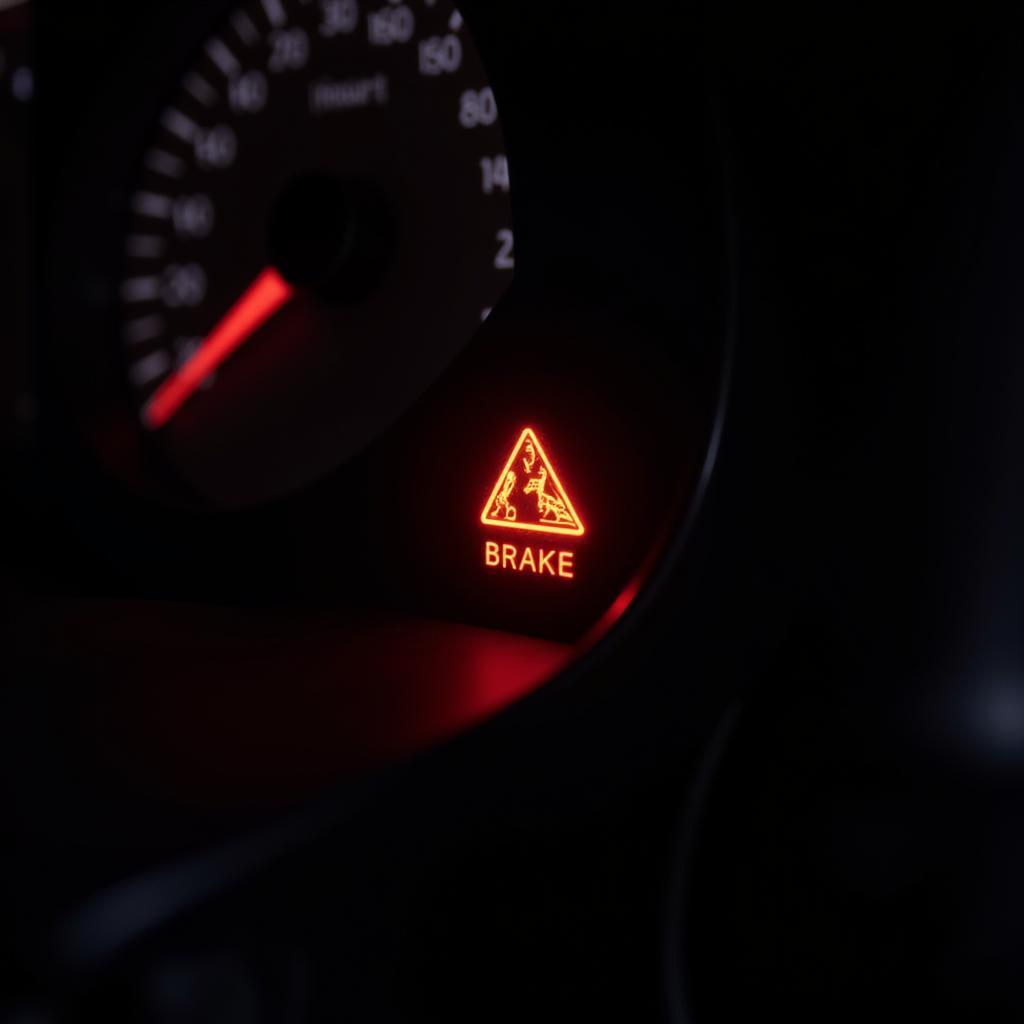That pesky Toyota brake system warning light glaring at you from the dashboard can be a real cause for concern. It’s a signal that something isn’t quite right with your braking system and demands immediate attention. This article will delve into the various reasons why your Toyota’s brake warning light might be on, offer troubleshooting tips, and discuss potential solutions, ranging from simple DIY fixes to more complex repairs requiring professional assistance.
Understanding Your Toyota’s Brake Warning Light
The brake warning light is part of your Toyota’s safety system, designed to alert you to potential issues within the braking system. It’s crucial to understand that this light can indicate several problems, from low brake fluid to more serious issues like a malfunctioning ABS (Anti-lock Braking System). Ignoring this warning could lead to compromised braking performance, putting you and other drivers at risk.
Common Causes of a Toyota Brake System Warning Light
Several factors can trigger the brake system warning light in your Toyota. Here are some of the most common culprits:
- Low Brake Fluid: This is often the most straightforward cause. Brake fluid levels naturally decrease over time as brake pads wear down.
- Worn Brake Pads: Thin brake pads can trigger the warning light as they approach the end of their lifespan.
- Parking Brake Engaged: Sometimes, the simplest explanation is the correct one. Ensure your parking brake is fully disengaged.
- ABS Issues: A problem with the Anti-lock Braking System, such as a faulty sensor or pump, can illuminate the warning light.
- Brake System Leaks: Leaks in the brake lines or other components can cause a drop in brake fluid pressure and trigger the warning light.
- Faulty Brake Light Switch: While less common, a malfunctioning brake light switch can sometimes trigger the brake warning light.
Troubleshooting Your Toyota’s Brake Warning Light
Before rushing to a mechanic, you can perform some basic troubleshooting steps to identify the potential issue.
- Check the Parking Brake: Make sure the parking brake is fully released.
- Inspect Brake Fluid Level: Locate the brake fluid reservoir (usually near the firewall) and check the fluid level. It should be between the minimum and maximum marks.
- Visually Inspect Brake Pads: If you’re comfortable doing so, check the thickness of your brake pads. If they appear excessively thin, they likely need replacement.
- Check for Leaks: Look for any signs of brake fluid leaks around the brake lines, calipers, and wheel cylinders.
When to Seek Professional Help
While some issues can be resolved with simple DIY fixes, others require the expertise of a qualified mechanic. If you’ve checked the basics and the warning light persists, or if you notice any of the following, it’s time to seek professional help:
- Soft or Spongy Brake Pedal: This indicates a potential issue with the brake system’s hydraulic pressure.
- Grinding or Squealing Brakes: These sounds usually point to worn brake pads or rotors.
- Pulling to One Side When Braking: This could be caused by uneven brake pad wear, a stuck caliper, or a brake system imbalance.
- ABS Warning Light Illuminated: This indicates a specific problem with the Anti-lock Braking System.
“A properly functioning brake system is paramount for safety,” says John Miller, a certified automotive technician with over 20 years of experience. “Don’t delay seeking professional help if you suspect a serious issue.”
Solutions for Common Brake System Issues
Depending on the diagnosed problem, the solution could range from a simple top-up of brake fluid to more complex repairs.
- Low Brake Fluid: Add the correct type of brake fluid to the reservoir, bringing the level to the maximum mark.
- Worn Brake Pads: Replace the brake pads with new ones. It’s generally recommended to replace both pads on the same axle simultaneously.
- ABS Issues: This requires professional diagnosis and repair, which may involve replacing sensors, the ABS module, or other components.
- Brake System Leaks: Leaks must be repaired immediately. This might involve replacing brake lines, seals, or other components.
“Regular brake system inspections are crucial for preventing major problems,” advises Sarah Chen, a senior automotive engineer. “Catching issues early can save you time, money, and most importantly, keep you safe on the road.”
Conclusion
The Toyota brake system warning light is a critical safety feature that shouldn’t be ignored. While some causes are relatively simple to fix, others require professional attention. By understanding the potential causes, performing basic troubleshooting, and knowing when to seek expert help, you can ensure your Toyota’s braking system remains in optimal condition, keeping you and others safe on the road. Don’t hesitate to contact a qualified mechanic if your Toyota brake system warning light persists or if you experience any unusual braking behavior.
FAQ
- Can I drive my Toyota with the brake warning light on? It’s strongly discouraged. The light indicates a potential problem with your braking system, and driving with compromised brakes is dangerous.
- How often should I check my brake fluid level? It’s a good practice to check your brake fluid level at least once a month.
- How long do brake pads typically last? Brake pad lifespan varies depending on driving habits and conditions, but they typically last between 25,000 and 70,000 miles.
- What is the cost of replacing brake pads? The cost varies depending on the Toyota model and the type of brake pads used.
- Is it safe to top up brake fluid myself? Yes, as long as you use the correct type of brake fluid specified in your owner’s manual.
- What does the ABS warning light look like? It’s typically a circular symbol with the letters “ABS” inside.
- Can worn brake rotors trigger the brake warning light? While not directly, excessively worn rotors can contribute to faster brake pad wear, which can then trigger the warning light.


